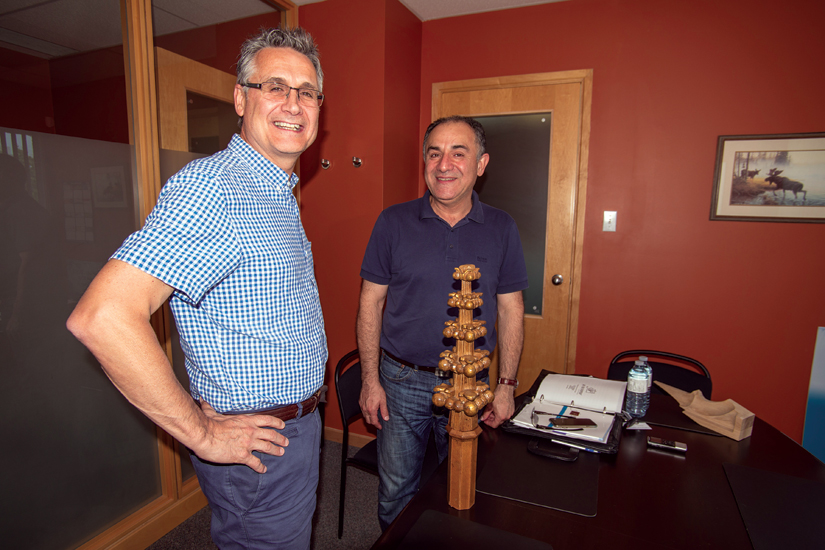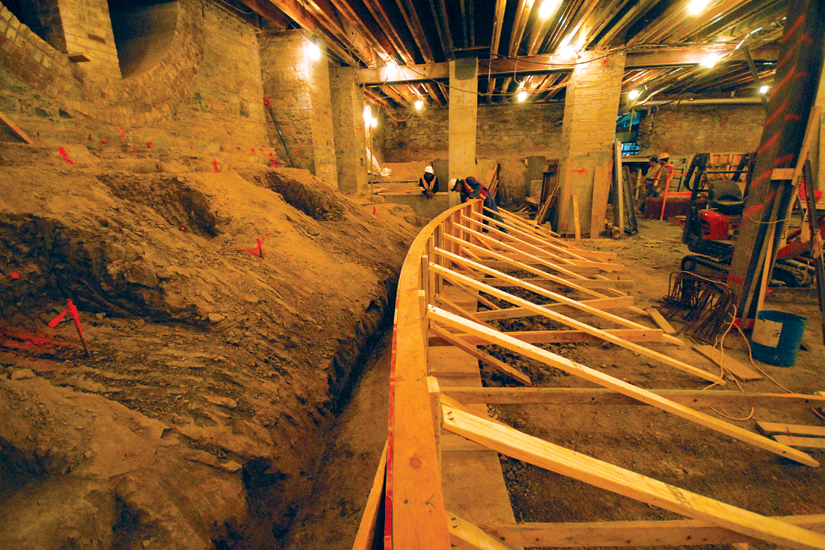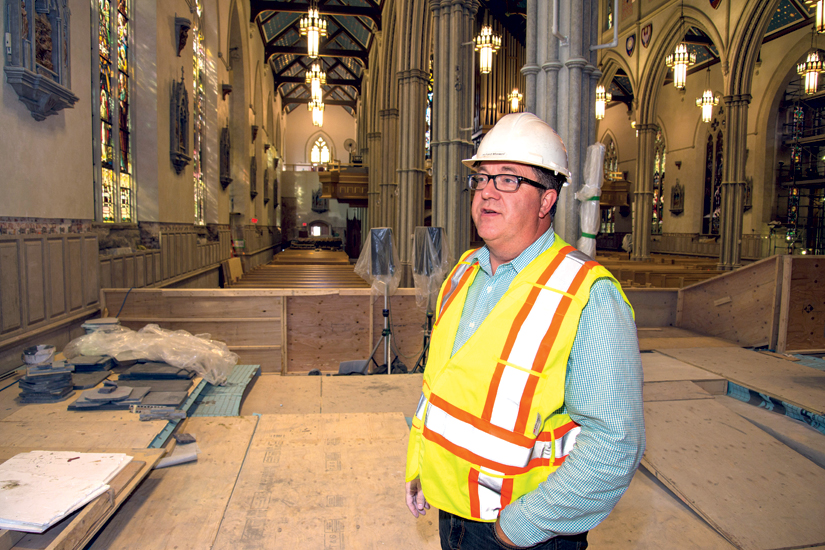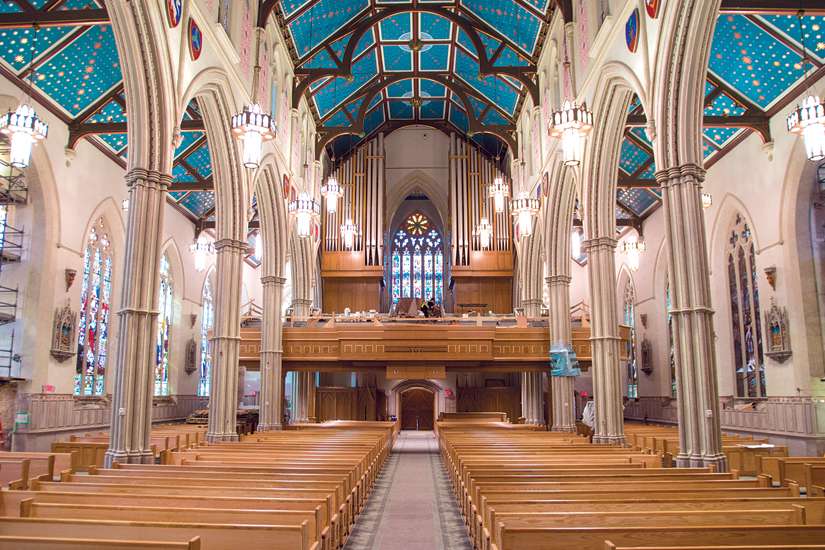“It started with a worker who was doing some duct work near a pillar,” Fr. Busch recalled. “He heard some clinking sounds, like some stones falling down.”
Those pillars might have looked solid, but the columns that seemed to be supporting the ceiling eight metres above were actually faux marble facades wrapped around 19th-century brick pillars. And the bricks were crumbling.
“They raised the alarm — a real alarm,” said Fr. Busch. “Everybody had to vacate the building. We were all standing out on the street while we had an engineer come in and see what was going on. Nobody was allowed to go in there.
“There were about three nights where I wasn’t sleeping. With every little noise I was thinking, ‘Is this thing falling down?’”
When Cardinal Aloysius Ambrozic prompted the new rector to start planning a cathedral renovation in 2006, he no doubt thought of St. Michael’s as a living thing. All Catholics know that churches, more than just bricks and mortar, are about the life breathed into them in the prayers and purpose of a living Catholic community. But as a physical building, St. Michael’s Cathedral was on life support. Her pastors were shocked when they discovered just how close to collapse their home had come.
Early on in the process, Fr. Busch thought it would be a good idea to clean up the exterior brick work. When an inspector came down from the roof to report on the steeple bricks, he asked the priest to follow him back up the ladder.
“I went up with him and with a little crowbar — you stuck it in a crack like this and the whole thing…” Words fail Fr. Busch at this point, so he leans side to side in his office chair to demonstrate how the tower swayed.
“And that’s just me. High wind, if it came along, could have blown the whole top of the steeple over. We’re lucky we started it when we did.”
A decade later, an immense renovation undertaking, perhaps the grandest project in the Catholic history of Toronto since the cathedral was first erected, has resulted in the restoration of St. Michael’s to its 19th-century glory — and then some. It has been stripped down, re-engineered, repaired and expanded to create a modern mother church for the archdiocese that has stayed true to the simple Gothic revival style of its original architect.
Neither Cardinal Ambrozic nor his successor later in 2006, Cardinal Thomas Collins, ever set out to spend $128 million on one of Toronto’s oldest churches. They just wanted to spruce it up a little, make it presentable.
It started with the front doors. They were shabby. Paint was peeling. Hinges were rusting. They looked like they had barely survived an invasion by Visigoths.
“From there we realized that the doors had lead paint. You scrape that and you interfere with the plaster. The plaster had asbestos. It just snowballed from there,” Fr. Busch said.
Devout believers and hardened atheists alike do the same thing when they walk into a cathedral, any cathedral. They look up. But when you step into the restored St. Michael’s Cathedral, spare a thought for what has happened below your feet. The entire cathedral received new underpinning.
“We had guys on their bellies for months with picks and shovels,” said Terco Construction president Richard Maxwell. “The guys were going through a maze, crawling on their bellies and bringing stuff out by pail.”
 Vince Parolin, left, owner of Art Magic, and Abbas Ghassemi of Art for Everyday oversaw a team of woodworkers who restored the cathedral to its old world splendour. (Photo by Michael Swan)
Vince Parolin, left, owner of Art Magic, and Abbas Ghassemi of Art for Everyday oversaw a team of woodworkers who restored the cathedral to its old world splendour. (Photo by Michael Swan)
Eventually, a tiny Bobcat excavator could manage under the church. Underpinning progressed half a metre at a time, expanding the basement over the course of three years from a dirt crawl space into usable rooms with three-metre high ceilings.
They never found the cornerstone Bishop Michael Power laid in 1845. It was probably removed in a previous attempt to patch the foundations.
“I doubt I will ever work on a project like this again in magnitude or this manner,” Terco said. “This is a completely different animal. The thing’s alive.”
No part of the cathedral has been untouched during the renovation project. The structure has been reinforced and the building has received new roofing, new or repaired windows, along with new lighting, video cameras, an elevator and new mechanical systems for heating and ventilation. The sanctuary has received remodelled reredos and side screens, new slate and marble flooring, and a larger choir area. An expanded balcony features a new Casavant organ and seating for 260 people. There are new pews, new and restored stained glass, several new statues, and two new bronze doors depicting the mysteries of the rosary. The ceiling has been painted in a cobalt blue with gilded stars in a heavenly sky to honour the original Gothic design. The exterior masonry and stone carvings have been restored. In addition to restoration of the crypts and a memorial for Bishop Michael Power, a crypt chapel will be built to seat about 300 people.
Woodworkers at Art Magic Carpentry and Art for Everyday have created some of the most visible and impressive elements of the restoration. With modern precision and old-world craft, the two Toronto-area companies have reproduced and replaced the work of master carvers from pre-Confederation Canada.
“We do magic, but not miracles,” said Art Magic owner Vince Parolin.
As they worked on finials, corbels, traceries and crosses, Parolin and Art for Everyday vice president Abbas Ghassemi found themselves daily confronted with examples of the careful work and deft, almost secret, skill of past generations.
“How did they do this without lasers?” was Parolin’s question as he inspected some of the carved elements of St. Michael’s interior decoration.
One hundred and sixty eight years on, Parolin and Ghassemi couldn’t even find wood to match the original wood.
“Back in those days the material was air dried. It was kept there for years and years and then later kiln dried. Now the material is cut, kiln dried and sent out. So it’s not seasoned as well as the material was way back when,” Parolin said.
Modern wood is more prone to shrink or expand, even change shape and colour, than wood hand picked by 19th-century craftsmen. Parolin found himself scouring lumber yards for wood from old growth forests, trying to locate the most stable, consistent material to supply a new generation of master carvers.
Where multiples were needed, and they were needed all over the church, master carvers produced a hand-carved model which was then mechanically reproduced with computer numerical controlled (CNC) machines. But Ghassemi’s machines were never built with a neo-Gothic cathedral in mind.
“The minute we laminated the material, all of a sudden it became 400 pounds, or 600 pounds. So how are we going to handle this? Is the CNC table able to carry that weight, for 10 hours going back and forth? What’s going to happen to the bearings?” Ghassemi asked.
Ghassemi had to modify and reprogram his computerized equipment to take the stress of neo-Gothic carving.
“We’re trying to marry the old with the new, and the new (building) codes,” said Parolin.
 The first step in the massive St. Michael’s renovation involved digging a new basement and installing new underpinning for the cathedral. (Photo courretsy of Concrete Pictures Inc.)
The first step in the massive St. Michael’s renovation involved digging a new basement and installing new underpinning for the cathedral. (Photo courretsy of Concrete Pictures Inc.)
But why bother? Fr. Busch is quite aware that $128 million could have bought the archdiocese a brand new cathedral — one built for a population of two-million Catholics who make up nearly a third of the Greater Toronto Area’s population. Building a new cathedral, however, wouldn’t solve the problem of St. Michael’s being a designated heritage building.
“Nobody would buy it because of the condition it was in,” Fr. Busch said. “The only other option is to tear it down, but you can’t tear it down. It’s designated historical. The city would never allow it. So even if we decided to build a new one, we were still stuck with fixing this one. There was no way around it.”
They could have done the bare minimum — structural steel to keep the steeple standing, new columns to keep the roof off the floor, new foundations to keep the whole thing from collapsing. That would have been $80 million, at least.
The idea of doing the minimum sets Cardinal Collins’ teeth on edge.
“If you don’t have time to do it right, when will you find time to do it over?” he asks. “Once you start into this you figure, ‘Well, let’s do it right.’”
That means more than adding washrooms (for generations the call of nature has been answered across the street in the St. Michael’s Choir School basement). Expanding the capacity of a cathedral that barely held 1,000 topped the Cardinal’s list.
“So I don’t have to do what I’ve done for 10 years — go up to the gates at Midnight Mass (Christmas eve) and apologize to the people for locking them out of Mass,” said the Cardinal. “This is not right. We want to have a Church of welcome.”
By replacing the long condemned choir loft with a new, expanded balcony, the main church will now accommodate 1,300. The crypt chapel downstairs will add another 300.
But the St. Michael’s restoration goes deeper than the physical needs of the cathedral parish. For Cardinal Collins it’s about the communion of the saints, linking us to our forbearers in faith.
Bishop Michael Power, founding bishop of Toronto, comes up each and every time Cardinal Collins talks about the cathedral. It isn’t just that Bishop Power personally contributed 350 pounds or more (about $70,000 in today’s currency) towards the 1,800-pound land fee for the cathedral, or that he laid the cornerstone in 1845 for a cathedral that would cost thousands more pounds to build — a ridiculously ambitious undertaking for a Catholic community of less than 3,000. He founded the Toronto Catholic Church in ways that run much deeper than the cathedral he founded.
His death ministering to Irish refugees demonstrated what sort of Church we were meant to be.
“What Pope Francis calls a field hospital — that wasn’t a metaphor for Michael Power. That was literally where he was in the fever sheds. That was the real thing,” said Cardinal Collins.
By restoring Bishop Power’s church, rather than casting it aside for a new model, Cardinal Collins hopes to reconnect Toronto Catholics with their roots.
“Twigs and branches get lonely if they’re cut off from their roots,” he said. “We’re a living organism. We’re not a building only.”
Just as our bodies are part of what it means to be alive, Toronto’s oldest Catholic church is part of what it means to live on as Catholics in Toronto, said Fr. Busch.
“It’s existed for 168 years. It has been a place of pilgrimage and prayer for 168 years. How do you just abandon that? How do you just throw that away? You can’t,” said Fr. Busch.
 Richard Maxwell doubts he’ll ever participate in another project of this magnitude. (Photo by Michael Swan)
Richard Maxwell doubts he’ll ever participate in another project of this magnitude. (Photo by Michael Swan)
For the sake of our heritage and a communion of saints that binds us together over generations — from the Irish of 1847 to today’s Christian refugees and migrants — the Archdiocese of Toronto has undertaken one of the most important and ambitious architectural restoration projects in Toronto history.
Heritage Toronto director of programming Kaitlin Wainwright can only compare it to the restoration of Union Station — a bigger building, but less than a century old. Though it’s the Catholic community and not any government which is restoring their cathedral, they’re doing it for the sake of the whole city, Wainwright said.
“It’s not enough to simply restore and conserve,” said Wainwright. “But telling the story of the history of the building as well as the restoration process is really important to helping the public understand its importance, and to contextualize it in the current day.”
That context is a city that is finally beginning to understand it has a history and its history matters, said Mayor John Tory.
“We’ve been relatively poor — I won’t say really poor, but relatively poor — at preserving our heritage,” Tory said. “I think you have to understand and appreciate your history in order to live in the city today.”
Tory understands that the restored cathedral is a gift to the city and the nation.
“If we think about how we occupy our time when we go to France or Italy or even to the United States, what are some of the places we visit?” the mayor asks. “It includes cathedrals and places of worship. Toronto should be seen no differently. These are very important buildings that are part of our history, that are beautiful buildings.”
It’s not an exercise in art history for Ludmilla Svitlana Tereshchenko, master gilder and owner of Royal Design and Decor. Tereshchenko and her crew have occupied the cathedral through the wee hours before sunrise applying gold leaf to the reredos, carved angels and stained glass window frames.
When the archdiocese wondered whether it really could afford 24-carat gold leaf on every detail, Tereshchenko donated $50,000 of her own supply of gold leaf. She and her crew would begin each night of work with prayer. Tereshchenko brought holy water from Montreal’s St. Joseph’s Oratory to bless her materials. She found herself with tears in her eyes as she worked on the church.
“It’s very hard to explain, like my feeling inside,” said the Ukrainian immigrant. “It’s a special time. It’s night time. It’s our feeling. It’s like ‘Oh, my gosh, God, thank you for this moment.’”
After work she would walk out into the dawn and the silent city waking up all around the cathedral. In 20 years in Canada, she’s gold-leafed Toronto’s Casa Loma and the homes of some of Canada’s wealthiest people, but this is different.
Cardinal Collins knows the difference that moved Tereshchenko to tears. He speaks of St. Michael’s as a mother — the mother church — that waits for everyone in Toronto.
“They will have the experience of this tremendous blessing for Toronto, for our whole city,” he said. “People will come from all over to experience the beauty of this — which is the beauty we offer to God, but it is also for the good of our neighbours.”
That spire on Bond Street announces something more than just a Catholic church and more than history.
“I’m not interested in building a museum,” said Fr. Busch. “I’ve said all the way along, this is not a historic relic. This is a living, vibrant community that we’re building for. We’re building for the future, as the first bishop did. He knew he was building more than they needed at the time, but he was building for what was to come.”
Restoring St. Michael’s Cathedral is no exercise in repeating the past. It restores the future, the hope, the dreams that were embedded in our founding.
“It’s kind of crucial,” said Cardinal Collins. “It’s that vibrant presence.”
The century rule
The century mark is the high standard being applied to every detail of the renovated cathedral. Every railing, carving, painting, finial, lintel, spire and spandrel must be made to last at least 100 years. Every craftsperson has sworn their contributions will easily survive a hundred years.
But thinking in centuries is intimidating when applied to the transient craft of journalists. This magazine is one of the items that will be placed in a time capsule to be embedded in a wall in the cathedral’s crypt chapel.
The full list of items to be preserved until 2116 is still undecided, but Angelus and Associates Ltd. project manager Carol Bragagnolo does want The Catholic Register magazine marking the cathedral’s rededication in the capsule.
Bragagnolo envisions a capsule more sophisticated than the steel boxes embedded in concrete of old.
“The idea is to use a modern technology device with the ability to be plugged in,” she said. “And to have all of the videos and documentaries created on the web site within the modern technology device.”
A rosary and a few other small items uncovered during excavation will be included. In the main, Bragagnolo hopes the time capsule will tell the story of the cathedral’s massive restoration and also tell the story of the 168-year history of St. Michael’s.
The capsule itself has not yet been designed. It will stand in for the missing corner stone laid by Bishop Michael Power in 1845.
“We wanted a record of the cathedral’s past and present work to pass on to the future parishioners, who are entrusted with this great legacy,” said rector Fr. Michael Busch.
Based on the 100-year standard applied to all the renovations, a fitting date to open the time capsule would be Sept. 29, 2116.
Gothic architecture has its own language
Anglo-Catholics of the romantic era from the late 1700s through the 1900s loved the Gothic. So it is inconceivable that a bishop of Michael Power’s generation, given the chance to build a cathedral, would advocate any other style.
Europe at the time was dotted with centuries-old pre-Enlightenment Gothic churches — Catholic, of course. A Gothic church could connect Toronto, a poor colonial outpost, with ancient European civilization.
Gothic architecture has spawned its own insider’s language. Discussing it demands a glass of absinthe and an understanding of a rich, convoluted vocabulary, including:
Flying buttresses: Usually made of brick, these structures at the side of a Gothic church once supported the tall exterior wall. Today they are largely decorative.
Reredos: The curved, ornamental screen or wall behind the altar.
Ambulatory: The walkway behind the reredos.
Clerestory: Windowed area above the side aisles and above the wall of the central part of the nave.
Nave: Main aisled part of a church extending from the narthex (main entrance) towards the altar.
Narthex: The gallery or porch at the west end of the church, above the main entrance. The altar, of course, is at the east end (at least theologically).
Finial: Small ornament topping off a spire, pinnacle or gable.
Gable: The roughly triangular, highly decorated bit above the door.
Lancet window: Smaller, pointed windows that are the surest sign a church is Gothic.
Mullion: Dividing bar of a rose or lancet window.
Transept: Forms the arms of a cross in the floor plan of a cross-shaped (cruciform) Gothic church.
(Correction: In an earlier version Terco Construction president Richard Maxwell was incorrectly referred to as Richard Terco)





























